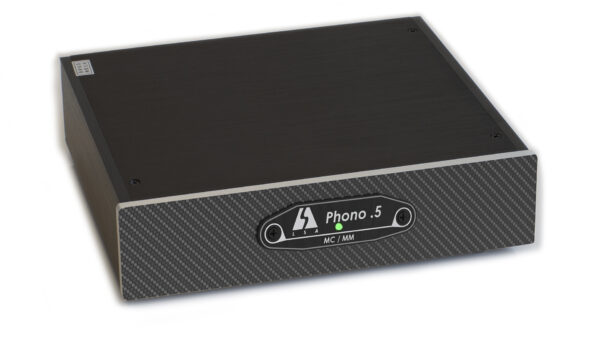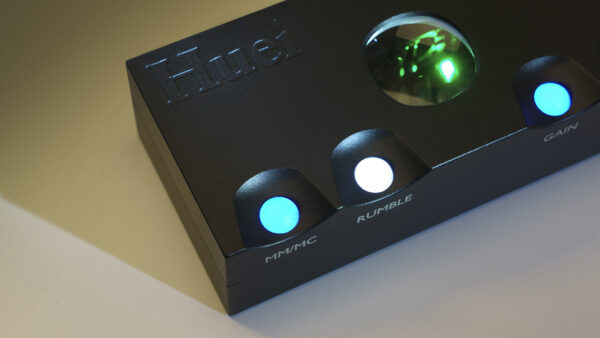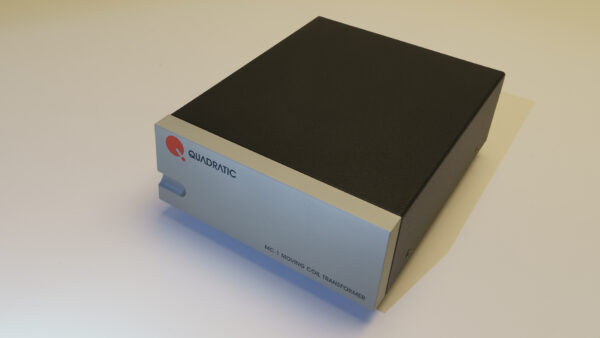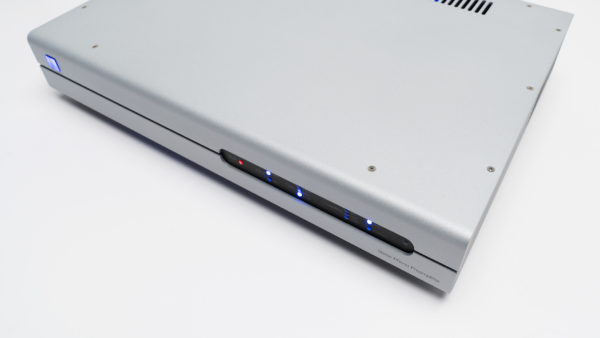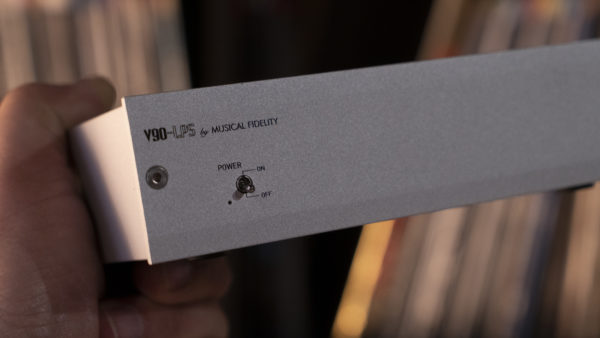Audio Research Reference phonostages are an excellent blend of performance, ergonomics and all around user friendliness, with the REF Phono at the top of the range, delivering world-class performance.
Having used more than one example from other manufacturers sporting those tiny DIP switches, (or worse yet requires removing the cover to access them,) the REF Phono 3’s front panel and remote control access make it effortless for those with multiple turntable/tonearm/cartridge configurations. Both inputs can be set to high or low gain with a wide range of loading options (50,100, 200, 500, 1000, 47k and custom), encouraging analog diversity.
With 51db (MM) and 73db (MC) on tap via the balanced outputs and 45/67db via the RCA outputs, no cartridge is off limits to the REF Phono 3. Excellent results are achieved auditioning a plethora of cartridges, from a vintage Ortofon VMS20 all the way to the Koetsu Onyx Platinum. Lovely as the REF is with premium cartridges, it brings out the best in any cartridge, regardless of price, making it an excellent choice for analog enthusiasts that run two turntables or tonearms. That second input is perfect for utilizing a modest cartridge for daily use, or more common pressings, saving your premium cartridge for your finest pressings.
EQ settings for RIAA, Decca, and Columbia, allows record collectors with a wide range of music to enjoy their selections exactly as they were meant to be heard. And again, all selectable from your listening position!
Getting down to business
Listening to the delicate, yet trippy effects in the recent vinyl reissue of Kruder & Dorfmeisters’ The K&D Sessions, it’s amazing how much more music the engineering staff at ARC manages to extract from familiar grooves when they introduce a new model. Their hybrid FET/Vacuum Tube topology came out of the chute well implemented in the early 1990s, but every model, even the interim SE models always deliver more dynamics and resolution. Vocals in “Going Under” are so chromatic and mind-bending, there are no speakers in the room, merely sound – everywhere.
Laurie Andersons’ backward vocal track in Jean-Michel Jarre’s obscure Zoolook, burrows straight into your skull, creeping up and back behind both ears, while the deep, synth bass line wafts right up from the floor, swallowing you up at high volume level. The REF Phono 3 is so quiet; you might inadvertently catch yourself cranking it up too far at times. Tweeters, beware!
I’ve owned nearly every phonostage Audio Research has built since the PH3, so I’ve spent a lot of time in this camp. Let’s get to the heart of the matter immediately: how much better is the REF Phono 3 than the REF Phono 2SE it replaces? A lot better. We’ll discuss that more as we go and I hope that I can give you enough information to decide if you need to make the trade up.
Define better
Those of you in the quest for the ultimate have probably made the jump immediately, or are getting ready to pull the trigger because that’s the way you roll. To put it in perspective, when you consider that the REF Phono 3 uses two additional 6H30s, has a bigger power supply with more current reserve than the outgoing REF Phono 2SE, it’s already a mega value. Add the updated styling of the current ARC lineup, and a $1,000 price increase makes it pretty easy to justify. The REF Phono 2SE was an award winner at $13,000 and the new one $14,000 will not disappoint.
Here’s the conundrum: Your current REF Phono 2SE doesn’t suck. Comparing the 2SE and the new 3 side by side proves that immediately. Only you will be able to decide if the price delta between selling or trading your 2SE in on a 3 is worth it to you. My judgment is lacking, so I’ll always tell you to go for it, just like I’ll always tell you to buy the cool car or motorcycle. Don’t look to me to be the voice of practicality – this is hifi at it’s best. Why wouldn’t you want the new shiny thing?
Here’s what will drive you nuts. Where the distance between the REF Phono 2SE and the flagship, two-box, $30,000 Reference Preamplifier was vast, the REF Phono 3 is closing the gap. But that’s what great engineers do; they learn from previous models and roll the changes inside. The REF Phono 3 is an excellent example of this practice.
The real heart of the REF Phono 3 is that it reveals more music than the model it replaces. Listening to well-worn, familiar musical selections that have been used as references for years, the new box provides a more immersive musical experience. As is true with all ARC products, there is a core dedication to a house sound that is as close to a lack of sound as possible. They have always strived for maximum dynamic range, minimal sonic coloration, and high resolution.
Some might accuse ARC components as not sounding “tubey enough,” but that’s not the point. If you want embellishment, look elsewhere. If you want to experience the music, this is what you are looking for.
When listening to acoustic instruments, there is more weight, depth, and texture to guitar and violin strings. Pianos sound more lifelike and natural. A lower noise floor means more air and space around notes, with more decay available. Greater power reserves mean a bigger “jump factor,” regardless of whether you are listening to a large orchestra or the heaviest metal.
The result with the REF 3 Phono is not one of hitting you on the head, but a subtle, yet substantial improvement over what has come before. If you are familiar with past models, you will notice the new and the familiar instantly.
About 500 records later
I can’t get enough of the REF Phono 3. The last three ARC phonostage reviews, I tried to contain my enthusiasm and wait until after the review to make the purchase. Not this time. And just to mix it up, our black anodized review sample is a nice detour from the standard ARC silver that I’ve nearly almost always chosen.
The past few iterations of the REF Phono have taken a few hundred hours to reach full song, and ARC tells you this – there’s a familiar yellow sheet of paper that suggests about 500 hours of playing time is required right inside the package. The new REF Phono 3 sounds better from day one than the past two did. It’s more open, livelier, punchier, more transparent, right away. Within 100 hours it goes from being amazing to being otherworldly.
With a set of 6H30 tubes under the perforated, transparent acrylic cover, there aren’t any opportunities for tube rolling; this is the only tube that works. Should you have an extra pile of twenty dollar bills lying about, if you can score a set of NOS 6H30s, they will give you a bit more performance, but I’m not sure it’s worth the agony. The factory tubes are all measured, graded and matched. And the REF Phono 3 is voiced around it, so check your OCD tendencies if you have them and just enjoy ARC’s creation.
For those not in the club
If you aren’t familiar with Audio Research, their products built by highly skilled technicians in their Minnesota factory, as they have been for over 40 years now. Their recent merger with The McIntosh group has added the industrial design skills of Italian design superstar Livio Cucuzza and his team in Italy – the same group that oversees the physical design of Sonus faber speakers.
ARC is long in this man’s blood, growing up with his fathers’ D79 and SP3 (which he now owns and has had fully restored), so the brand couldn’t be in better hands. Cucuzza has made a tasteful visual update to the classic ARC look, staying true to the past, yet a perfect look for the future. The resulting balance is perfect; vintage and current ARC components still look fantastic on the rack together, yet the new style is more engaging and fashion forward.
The circuitry is all designed here in the US, and each REF component goes through multiple layers of hand sorting, assembly, testing and final listening. Tubes are matched, graded, sorted and marked before going inside any component, and the same excruciating process is performed on every resistor, capacitor, and transformer. No stone is left unturned; multiple variations of internal wire were auditioned before settling on the current iteration. The staff even investigated different printed circuit board coatings, looking for the least sonic signature.
No less than four separate checks are made along the assembly path, and every REF Phono 3 is powered up twice before being gently inserted into its packing carton. The first power-up is to make sure all functions work properly, the second is an actual listening test in the ARC listening room, to be sure there are no anomalies in the sound before it leaves the factory. This dedication to excellence is what makes ARC components such a great value. You need to look no further than eBay or Audiogon to see the high price that past products command, with some selling for more than their original price decades later. Considering you could pay three times what the REF Phono 3 costs and not get more performance, awarding it one of our Exceptional Value Awards for 2017 is easy.
The Audio Research REF Phono 3
$14,000
PERIPHERALS
Turntable Grand Prix Audio Monaco/Triplanar
Cartridges Lyra Atlas, Lyra Etna, Ortofon Cadenza Bronze
Preamplifier Pass XS Pre
Power Amplifier Pass XS300 Monos
Cable Cardas Clear

